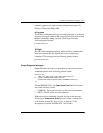
Chapter 9. Transaction Language 1 (TL1)
9-2 MX2800 STS-1 User Manual 61200659L1-1
management port enabled, a valid IP and gateway address, and a
valid subnet mask.
Once the Telnet connection is established, it is necessary to initiate
a TL1 session. Establishing a TL1 session involves successful user
authentication. Until a TL1 session is established, all commands
other than those used to initiate or terminate a session will be
denied (autonomous messaging is also disabled). Authentication
involves the successful entry of a
username/password
pair. A
table of usernames and associated passwords and privileges is kept
for TL1 authentication. This table is maintained by an administrator
through the VT-100 menus or through a TL1 session. For
information on using the Act-User command to initiate a TL1
session, see the section TL1 Commands on page 9-5.
TL1 MESSAGES
As stated earlier, TL1 messages are either part of a command-
response exchange or are generated autonomously.
The general format for a TL1 command is as follows:
Refer to TL1 Commands on page 9-5 for a list of TL1 commands
supported by the MX2800 STS-1.
TL1 Responses
There are three types of TL1 responses:
• Acknowledgment messages
• Output Response messages
• Autonomous messages
Acknowledgment Messages
Acknowledgment messages are brief output messages generated in
response to received TL1 commands. The MX2800 STS-1
<VERB>[-<MOD1>[-<MOD2>]]:[<TID>]:[<AID>]:[<CTAG>]:[GB](:<PARAMx>(,<PARAMx>)*)*;


















